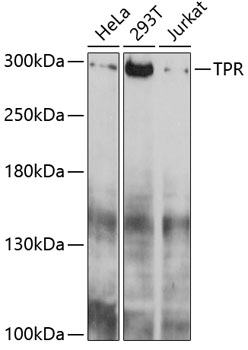-
Product Name
TPR Polyclonal Antibody
- Documents
-
Description
Polyclonal antibody to TPR
-
Tested applications
WB
-
Species reactivity
Human
-
Alternative names
TPR antibody; nucleoprotein TPR antibody
-
Isotype
Rabbit IgG
-
Preparation
Antigen: A synthetic peptide of human TPR
-
Clonality
Polyclonal
-
Formulation
PBS with 0.02% sodium azide, pH7.3.
-
Storage instructions
Store at 4℃. Avoid freeze / thaw cycles.
-
Applications
WB 1:500 - 1:2000
-
Validations

Western blot - TPR Polyclonal Antibody
Western blot analysis of extracts of various cell lines, using TPR antibody at 1:1000 dilution.Secondary antibody: HRP Goat Anti-Rabbit IgG (H+L) at 1:10000 dilution.Lysates/proteins: 25ug per lane.Blocking buffer: 3% nonfat dry milk in TBST.Detection: ECL Basic Kit .Exposure time: 30s.
-
Background
Component of the nuclear pore complex (NPC), a complex required for the trafficking across the nuclear envelope. Functions as a scaffolding element in the nuclear phase of the NPC essential for normal nucleocytoplasmic transport of proteins and mRNAs, plays a role in the establishment of nuclear-peripheral chromatin compartmentalization in interphase, and in the mitotic spindle checkpoint signaling during mitosis. Involved in the quality control and retention of unspliced mRNAs in the nucleus; in association with NUP153, regulates the nuclear export of unspliced mRNA species bearing constitutive transport element (CTE) in a NXF1- and KHDRBS1-independent manner. Negatively regulates both the association of CTE-containing mRNA with large polyribosomes and translation initiation. Does not play any role in Rev response element (RRE)-mediated export of unspliced mRNAs. Implicated in nuclear export of mRNAs transcribed from heat shock gene promoters; associates both with chromatin in the HSP70 promoter and with mRNAs transcribed from this promoter under stress-induced conditions. Modulates the nucleocytoplasmic transport of activated MAPK1/ERK2 and huntingtin/HTT and may serve as a docking site for the XPO1/CRM1-mediated nuclear export complex. According to some authors, plays a limited role in the regulation of nuclear protein export. Plays also a role as a structural and functional element of the perinuclear chromatin distribution; involved in the formation and/or maintenance of NPC-associated perinuclear heterochromatin exclusion zones (HEZs). Finally, acts as a spatial regulator of the spindle-assembly checkpoint (SAC) response ensuring a timely and effective recruitment of spindle checkpoint proteins like MAD1L1 and MAD2L1 to unattached kinetochore during the metaphase-anaphase transition before chromosome congression. Its N-terminus is involved in activation of oncogenic kinases.
Related Products / Services
Please note: All products are "FOR RESEARCH USE ONLY AND ARE NOT INTENDED FOR DIAGNOSTIC OR THERAPEUTIC USE"
